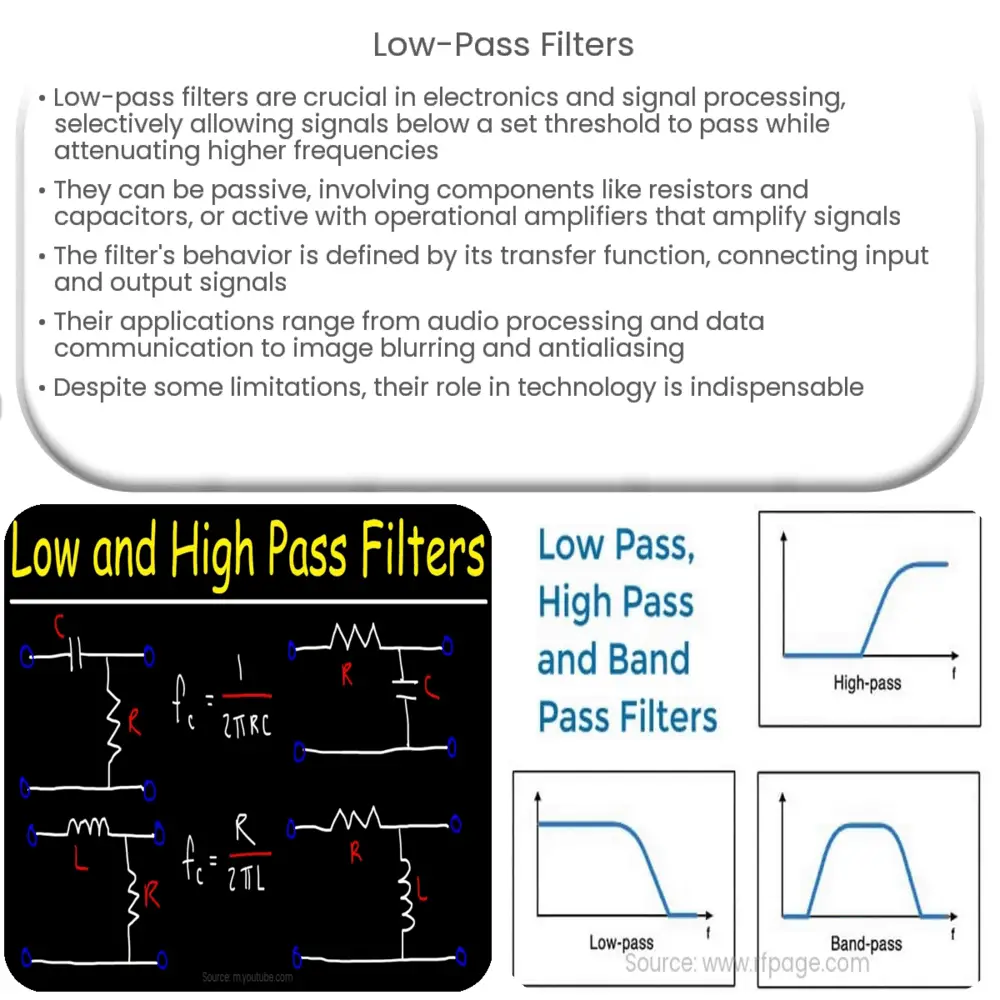Explore the basics of low-pass filters, their types, functioning, applications in audio, data communication, and electronics. Learn about their strengths and limitations.

Understanding Low-Pass Filters
Low-pass filters are vital components within the realm of electronics and signal processing. They serve an essential function, eliminating unwanted high-frequency signals and allowing only signals below a specified threshold or cutoff frequency to pass through. This makes low-pass filters integral in various applications, from audio systems and communications technology to digital signal processing.
Basic Principle
A low-pass filter works on the principle of frequency selectivity, enabling it to ‘pass’ signals with a frequency lower than its cutoff frequency while attenuating frequencies higher than the cutoff point. The degree of attenuation depends on the specific type of low-pass filter being used.
Types of Low-Pass Filters
- Passive Low-Pass Filters: These filters involve passive components, like resistors, capacitors, and inductors. The simplest form of a passive low-pass filter consists of a resistor and a capacitor, known as an RC Low-Pass Filter.
- Active Low-Pass Filters: These involve active components such as operational amplifiers, alongside resistors and capacitors. Active filters are capable of amplifying signals, an advantage over their passive counterparts.
The Transfer Function
The behavior of a low-pass filter can be mathematically described by its transfer function. This equation expresses the relationship between the input and output signals of the filter. It involves the cutoff frequencyc and the frequency of the input signali.
Low-Pass Filter in the Frequency Domain
Low-pass filters are often represented in the frequency domain for analysis. The frequency response curve of a typical low-pass filter is characterized by two distinct regions. The ‘passband’ where frequencies are allowed to pass through, and the ‘stopband’ where higher frequencies are blocked or significantly attenuated.
Applications of Low-Pass Filters
Low-pass filters have a multitude of applications in various fields. Here are some common ones:
- Audio Processing: Low-pass filters are widely used in audio processing to remove high-frequency noise or to simulate the effect of distance (since high-frequency sounds diminish over distance).
- Data Communication: In data communication systems, these filters are used to limit the bandwidth of the transmitted signal, reducing interference.
More Applications of Low-Pass Filters
- Image Processing: In digital image processing, low-pass filters are used to blur images or to reduce high-frequency noise.
- Electronics: They are used in electronic circuits to block high-frequency noise in power supplies.
- Antialiasing: They play a significant role in the antialiasing process during signal digitization to prevent high-frequency components from being misinterpreted.
Characteristics of a Good Low-Pass Filter
A good low-pass filter should have certain characteristics. In the passband, the filter should ideally have a flat frequency response, with minimal attenuation of the desired signal. In the stopband, it should provide a high degree of attenuation to block undesired frequencies. The transition between the passband and stopband should be as sharp as possible.
Limitations and Challenges
While low-pass filters are invaluable tools in electronics and signal processing, they do have limitations. For instance, a filter’s sharpness—its ability to distinguish between frequencies near the cutoff frequency—is often a compromise between signal fidelity and complexity of design. Additionally, in real-world applications, filters may introduce phase shifts and transient responses, which can impact the quality of the processed signal.
Conclusion
In conclusion, low-pass filters play a vital role in many technological applications, facilitating the reduction of noise and the smooth functioning of electronic systems. They offer an effective solution to manage and shape the frequency content of signals. Despite their limitations and the challenges faced in practical implementation, their contribution to the advancement of modern technology is undeniable. Understanding the concept, functionality, and practical implications of low-pass filters is fundamental to anyone pursuing a career or interest in electronics and signal processing.

